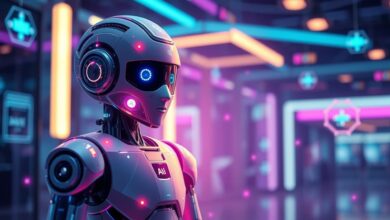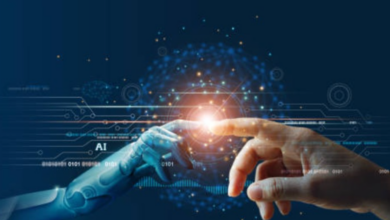7 Powerful Types of Robotics Revolutionizing Our World
Discover 7 Game-Changing Robotics Types Shaping Industries & Everyday Life with Smart Automation & AI!
Robots are changing the world! From factories to hospitals, different types of robotics are making life easier and working faster. These smart machines help humans by performing tough, boring, or dangerous tasks. Many industries, like healthcare, farming, and transportation, now use robots every day.
With automation and AI, robots are getting even smarter. As a result, they can think, learn, and make decisions on their own. For example, self-driving cars, robotic surgeons, and delivery drones are just a few amazing examples. Moreover, these machines work 24/7 without breaks, making things more efficient.
The future of robotics is exciting! Imagine robots helping with homework, cooking meals, or even exploring space. Some robots even look and talk like humans! As technology improves, robots will become even more helpful in our daily lives.
But how do these robots work? What are the most powerful types? In this article, we’ll explore seven game-changing robotics types that are shaping our world. Get ready to discover how these machines are making the future smarter, faster, and safer!
Industrial Robotics: Powering Manufacturing
Factories use robots to build things faster and better. Specifically, these robotics types are called industrial robots. In manufacturing and assembly lines, they help by handling heavy tasks, cutting materials, and putting parts together. Furthermore, these automation robots work non-stop without getting tired.
For instance, many factories use factory robots to make cars, phones, and even toys. In the automotive industry, robotic arms help build cars with great accuracy. They paint, weld, and assemble parts quickly. As a result, this makes cars safer and production faster.
Today, there are over 3 million industrial robots working in factories around the world (IFR report). These robots help companies save time and money. They also reduce mistakes and improve product quality.
As technology improves, robotic types will become even smarter. Soon, factories will use more automation robots to create new products. Industrial robots are shaping the future of manufacturing, making it faster, safer, and more efficient!
Service Robots: Enhancing Daily Life
Robots are not just in factories—they help people every day! These robotics types are called service robots. They work in healthcare, hospitality, and personal assistance. They make life easier by helping doctors, guiding customers, and even cleaning homes.
In hospitals, medical robots assist doctors in surgeries. They also help patients recover faster. In hotels and restaurants, AI-powered robots serve food and answer questions. Many businesses use customer service bots to greet visitors and provide information.
A great example is the Pepper robot, which works in stores. It talks to customers, answers questions, and even tells jokes! People enjoy interacting with it, making shopping fun.
As technology improves, robotic types will become even more helpful. They will assist the elderly, clean streets, and even teach in schools! Want to learn more? Check out our detailed guide on robot interaction!
Humanoid Robots: Bridging the Human-Machine Gap
Some robots look and act like humans! Specifically, these robotics types are called humanoid robots. They have arms, legs, and faces like people. Moreover, they can walk, talk, and even show emotions. Because of these abilities, these robots help in research, customer service, and even entertainment.
For example, many android robots can smile, blink, and respond like humans. Additionally, bipedal robots walk on two legs, just like us. Some even dance! With the help of emotional AI, these robots understand feelings and respond in a friendly way.
A famous example is Sophia, by Hanson Robotics. She talks to people, answers questions, and even jokes. She once spoke at the United Nations! People love interacting with her because she feels almost real.
The future of humanoid robots is bright! Experts say the market for these robots will grow to $3.9 billion by 2028. Soon, they might help in schools, hospitals, and even at home. As technology improves, these robots will become even smarter and more helpful!
Autonomous Vehicles & Drones: The Future of Mobility
Cars and drones are getting smarter! Thanks to AI navigation, these robotics types can move on their own. As a result, they help people travel, deliver packages, and make roads safer. For example, self-driving cars use autonomous driving to operate without a driver. They not only follow traffic rules but also stop at lights and avoid accidents.
Drones are also changing the world. Delivery drones bring packages fast and safely. Companies like Amazon Prime Air use them to deliver orders in minutes! In big cities, drones help transport medicines and supplies quickly.
In logistics, UAVs (unmanned aerial vehicles) track shipments and scan warehouses. They save time and make work easier. With better technology, these robots will soon play a bigger role in everyday life.
Want to know more about smart and green transport? Read our article on Top Sustainable Transportation Methods!
Military & Defense Robots: The Future of Warfare
Robots are now part of the military! These robotics types help soldiers stay safe and complete tough missions. For instance, they include AI-driven robotic soldiers, military drones, and surveillance bots. Moreover, they work in dangerous places where humans cannot go.
As a result, robotic warfare is changing how battles are fought. With the help of defense automation, armies use smart machines for security. For example, military drones fly over enemy areas to gather information. Some even deliver supplies to soldiers in remote locations.
A great example is Boston Dynamics’s robotic dog. Not only does it help with security patrols, but it also checks for dangers without risking human lives. Overall, these robots make the military stronger and more prepared.
The future of military robotics is growing fast. Experts predict that this market will rise by 12.3% CAGR by 2030. Soon, armies will use more smart machines to protect people and keep the peace.
Medical Robotics: Advancing Healthcare
Robots are saving lives! These robotics types help doctors and nurses in hospitals. For example, they assist in surgery, rehabilitation, and patient care. As a result, they make treatments safer and faster.
Specifically, surgical robots help doctors perform delicate operations. One great example is the Da Vinci surgical robot. With its advanced technology, it allows doctors to do minimally invasive surgeries with tiny cuts. This means that patients heal faster with less pain.
Robotic prosthetics help people walk, move, and live better. These smart limbs respond to brain signals and work just like real arms or legs. AI healthcare robots also support patients. They remind them to take medicine, check their health, and even offer company.
Medical robots are the future of healthcare. They make treatments more precise, reduce mistakes, and help patients recover quickly. As technology improves, hospitals will rely more on these smart machines to save lives.
Agricultural Robots: Transforming Farming
Farming is getting smarter! Thanks to technology, these robotics types help farmers grow more food with less effort. For instance, agricultural robots assist in planting, harvesting, and precision agriculture. As a result, they make farming faster and more efficient.
In addition, agribots work in the fields day and night. They not only plant seeds but also remove weeds and pick ripe fruits. With the help of smart farming, robots check soil health and water crops at the right time. This way, farmers save resources and grow better crops.
A perfect example is John Deere’s autonomous tractors. These advanced machines drive themselves and help farmers get the best crop yield. By using AI in agriculture, they make smart decisions and improve farming.
The future of farming is high-tech! Experts say the agricultural robotics market will reach $20 billion by 2026. As farms get bigger, more robotic helpers will be needed. Soon, farming will be easier, greener, and more productive!
FAQs
What are the main types of robotics?
Robots come in many shapes and sizes! Here are seven powerful robotics types:
- Industrial Robots – These robots work in factories. They build cars and assemble products with robotic arms.
- Service Robots – These help in hospitals, hotels, and homes. AI-powered robots assist people with daily tasks.
- Humanoid Robots – These look and act like humans. They talk, walk, and show emotions.
- Autonomous Vehicles & Drones – Self-driving cars and delivery drones move goods and people without a driver.
- Military & Defense Robots – These robots keep borders safe. Robotic soldiers and surveillance drones help in defense.
- Medical Robotics – These help doctors with surgery and patient care. Surgical robots perform precise operations.
- Agricultural Robots – These work on farms. Agribots plant, water, and harvest crops.
How do robotics impact industries today?
Robots make work faster and easier. For example, automation robots help businesses produce more in less time. In factories, robots build cars, phones, and machines with great precision. Meanwhile, medical robots assist doctors in surgery, making procedures safer.
In addition, customer service bots in stores answer questions and help shoppers. Furthermore, AI navigation in self-driving cars makes roads safer by reducing accidents. Overall, robots boost efficiency in many industries!
Which type of robotics is growing the fastest?
The fastest-growing robots are autonomous vehicles and AI-powered service robots. Self-driving cars are improving daily. Companies use delivery drones to bring packages quickly. Medical robots are also advancing fast, helping doctors with surgeries and patient care. The world is moving towards smarter robots!
How do humanoid robots differ from service robots?
Humanoid robots look like humans. They walk, talk, and even express emotions. Service robots, however, focus on tasks like customer service or cleaning. Android robots like Sophia can hold conversations. But service bots like Pepper greet customers and provide information. Both help people but in different ways!
What is the future of robotics?
The future of robotics is exciting! With AI integration, robots will become even smarter. Moreover, emotional AI will help them understand feelings and respond better. Soon, bipedal robots may walk just like humans. Meanwhile, autonomous driving will completely change transportation, making travel safer and easier.
Additionally, robots will work in space, factories, and even homes, assisting with daily tasks. As a result, the world is becoming more automated, and robots will soon be a natural part of everyday life!
Conclusion
Robots are changing the world in amazing ways! From factories to homes, the robotics types we explored are helping in many areas. For instance, they assist in hospitals, farms, and industries, making work easier, faster, and safer. Whether it’s robotic arms building cars or drones delivering packages, these smart machines are everywhere.
Meanwhile, technology is growing fast, and robots are getting even smarter. With the power of AI and automation, they can learn new skills and work independently. Shortly, robots might help with household chores, explore space, or even care for the sick. The possibilities are endless!
Want to know more about robotics types and how they shape our world? Stay updated on the latest advancements in AI and automation. The future belongs to those who learn and adapt. Explore How AI Is Revolutionizing Industries & Sectors to Stay Ahead!









